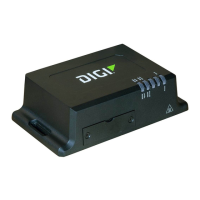Manage networks and connections View network interface status
Digi TransPort WR Routers User Guide 761
Operational Mode
The operational mode that the DSL modem is in when in the Up state. It is in the format of:
<Mode> Annex <A | B | M>
where the <Mode> can be one the following:
• ANSI
• ETSI
• G.dmt
• G.lite
• ADSL2
• ADSL2+
Remote Vendor ID
The remote vendor ID of the DSLAM that the DSL interface connected to.
Speed
The current speed the downstream and upstream DSL channels in Kbps.
Channel
The channel type in use. It can be either Fast or Interleaved.
Relative Capacity
The current relative capacity on the downstream and upstream DSL channels. The relative
capacity is the percentage of your overall available bandwidth fir obtaining your ATM service
rate.
Attenuation
The current attenuation, in decibels, on the downstream and upstream DSL channels.
Attenuation is the measure of how much the signal has degraded between the DSLAM and the
DSL modem. The lower the attenuation, the better the performance will be.
Noise Margin
The current noise margin, in decibels, on the downstream and upstream DSL channels. The
noise margin (aka Signal to Noise Ratio) is the relative strength of the DSL signal to noise. The
larger the noise margin, the better the performance will do. In some instances, interleaving can
help raise the noise margin.
Power Output
The current amount of power, in dBm, that the DSL modem (upstream) and DSLAM
(downstream) are using. The lower the power output, the better the performance.

